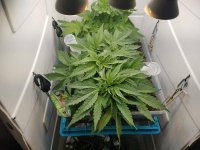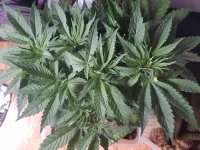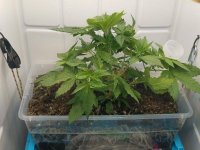-
ICMag with help from Phlizon, Landrace Warden and The Vault is running a NEW contest for Christmas! You can check it here. Prizes are: full spectrum led light, seeds & forum premium access. Come join in!
You are using an out of date browser. It may not display this or other websites correctly.
You should upgrade or use an alternative browser.
You should upgrade or use an alternative browser.
Off the shelf retail store screw-in LED and CFL bulb comparisons
- Thread starter blynx
- Start date
brown_thumb
Active member
RE the bulbs I mentioned in post #901. These are rated at 100w equivalent but they seem far brighter to me... to MY eyes they look more like 200w. They're a bit painful to look at even with the diffusing globes still attached. Their rated power consumption is 15w and actual tested is 15.6w. I have no way to test lumens. My observations are purely subjective.
RE the bulbs I mentioned in post #901. These are rated at 100w equivalent but they seem far brighter to me... to MY eyes they look more like 200w. They're a bit painful to look at even with the diffusing globes still attached. Their rated power consumption is 15w and actual tested is 15.6w. I have no way to test lumens. My observations are purely subjective.
Wattage tends to go down after a while of being on.
LEDs pull less volt as the temperature goes up.
brown_thumb
Active member
^^^ I tested mine at an ambient temperature of about 70 F and left the bulbs on a full minute after the current usage stabilized, which only took a few seconds. It never fluctuated more than 1/10 watt. After about 10 seconds the current consumption didn't change. I'm not sure if that fluctuation is a function of the bulb or the wattage monitor I used.
You intended to say LEDs pull less 'current' as temperature rises? I didn't know LEDs behaved that way. I know fluorescent lamps have a higher initial current draw.
You intended to say LEDs pull less 'current' as temperature rises? I didn't know LEDs behaved that way. I know fluorescent lamps have a higher initial current draw.
MdNewgrower
Active member
Here are pics from yesterday. 1 full frontal view of both plants together, a second with just The Runt(4w 2d old today), and a top view of #1(5 weeks old today).
Currently at 12 8.5/9w leds, 8 5000k and 4 2700k.
Currently at 12 8.5/9w leds, 8 5000k and 4 2700k.
Attachments
chronosync
Well-known member
looking good!
I managed to collect all of mine from Menards. They are all 75 watt equivalent and I picked them up for like $3ish a bulb. Started with two rows of 5, and expanded with an additional 4 a few weeks later. I had grown with a 150 HPS + 75 MH + ~100watt CFL for a couple years and these 14 LEDs are kicking that setups ass. I couldn't believe it at first and now I am just stoked!
What are your observing in the effect of cannabis when compared to the old lights?
green member
Member
Would you guys say this is light burn? Running 102 watts (de-globed) screw in LED in 3sqft. Lights are about 8 inches from canopy. Plants in veg are fine, then develop this in early flower. LG's soiless mix #1 LABS and IMO every other watering. Happy New Year!



It's not burning, it's something else related to those LEDs, because I have seen it also on Terpenes plants...
(I have my plants in veg at 6" distance and they also look superb )
)
(I have my plants in veg at 6" distance and they also look superb
It's not burning, it's something else related to those LEDs, because I have seen it also on Terpenes plants... )
Do you think it's related to the wattage of the specific bulbs or the brand? Just curious as I plan to load up my 4x2 area with 9w'ers and don't want to over do it...
No, I think it's something related to those white LEDs, because I haven't seen that with those violet ones...
Maybe mixing spectrums will avoid that, but I don't know, maybe is some deficiency, maybe Calcium (maybe I'm stupid)?! we should research that
Maybe mixing spectrums will avoid that, but I don't know, maybe is some deficiency, maybe Calcium (maybe I'm stupid)?! we should research that
chronosync
Well-known member
They are wired in series
=D-----=*=*=*=*
I used plastic sockets that have screw connectors inside so no soldering
The frame was put together with dry wall screws and made from scrap, the sockets were screwed down to the frame the same way. I only had to buy the bulbs, sockets, and some wire. It's pretty rough looking but I think it will be fine, I made a baffle out of black foam poster board that hangs in front of the lights off the front tent post to shield my eyes some. It hangs down like a curtain about even with the rim of the bulbs, you cant see the mess
=D-----=*=*=*=*
I used plastic sockets that have screw connectors inside so no soldering
The frame was put together with dry wall screws and made from scrap, the sockets were screwed down to the frame the same way. I only had to buy the bulbs, sockets, and some wire. It's pretty rough looking but I think it will be fine, I made a baffle out of black foam poster board that hangs in front of the lights off the front tent post to shield my eyes some. It hangs down like a curtain about even with the rim of the bulbs, you cant see the mess
Wiring is the easiest it can be, just wire all + to all +, and all - to all - and that's it! Plus is the bottom of bulb, and minus is on the side where you screw the bulb 
S
sillyhead123
This thread is huge now. I'm getting rid of my UFO led 90w and 270w. The loud fans, annoying pink / blue color is getting hard to hide. I'm only in a 2x1 space.
What color spectrum for veg/flower? What wattage to get same yield as the 270w(180w ufo)? Also any flush mount mounts?
What color spectrum for veg/flower? What wattage to get same yield as the 270w(180w ufo)? Also any flush mount mounts?
^^^ I tested mine at an ambient temperature of about 70 F and left the bulbs on a full minute after the current usage stabilized, which only took a few seconds. It never fluctuated more than 1/10 watt. After about 10 seconds the current consumption didn't change. I'm not sure if that fluctuation is a function of the bulb or the wattage monitor I used.
You intended to say LEDs pull less 'current' as temperature rises? I didn't know LEDs behaved that way. I know fluorescent lamps have a higher initial current draw.
Taking a datasheet from any random LED
http://www.samsung.com/global/busin...products/201611/Data_Sheet_LH351D_Rev.1.0.pdf
Page 15.
The samsung diode pulls 2.95 volt (with 1.05A) when the junction temp is 25 degrees celcius.
With the junction temp at 90 degrees it pulls 2.9 volt.
Though it's a rather small change.
Maybe it's just the driver that initially pulls a bit more before stabilizing like with CFLs.
Looks more a potassium deficiëncy to me.I read also from others who are growing with Cree LEDs icw soilless setups having deficiencies with calcium, magnesium etc.
Last edited:
brown_thumb
Active member
Taking a datasheet from any random LED
http://www.samsung.com/global/busin...products/201611/Data_Sheet_LH351D_Rev.1.0.pdf
Page 15.
The samsung diode pulls 2.95 volt (with 1.05A) when the junction temp is 25 degrees celcius.
With the junction temp at 90 degrees it pulls 2.9 volt.
Though it's a rather small change.
Maybe it's just the driver that initially pulls a bit more before stabilizing like with CFLs.
Thank you. I understood nearly none of that PDF.
HuffnPufferfish
Member
that pic looks like P or Cal one could even lockout the other, i think
when you wire bulbs, plus and min dont matter, just think of 1 for power in 1 for power out
when you wire bulbs, plus and min dont matter, just think of 1 for power in 1 for power out





